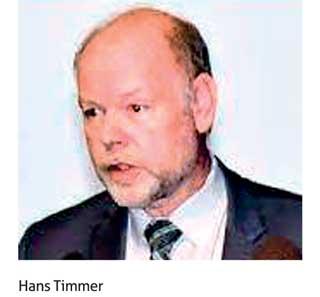08 Oct 2021 - {{hitsCtrl.values.hits}}
The medium term outlook for Sri Lanka is “clouded” by pre-existing macroeconomic weaknesses and scarring left by the Covid-19 pandemic, the World Bank (WB) said, although the economy is expected to expand by 3.3 percent in 2021.
 According to the latest South Asia Economic Focus titled ‘Shifting Gears: Digitization and Services-led Development’, while the country has done well to vaccinate more than 50 percent of the total population so far, the government focusing on targeted measures to prevent further COVID-19 waves could dampen economic recovery.
According to the latest South Asia Economic Focus titled ‘Shifting Gears: Digitization and Services-led Development’, while the country has done well to vaccinate more than 50 percent of the total population so far, the government focusing on targeted measures to prevent further COVID-19 waves could dampen economic recovery.
“The pandemic has brought unprecedented disruptions to education and the learning losses will be a drag on the country’s human capital gains. Targeted policies to reverse trends of long-term inequality and reduce gaps in equity are priority to realize growth prospects,” said WB Country Director for Maldives, Nepal, and Sri Lanka Faris Hadad-Zervos in a statement highlighting the developments observed in the Sri Lanka chapter.
The WB expects growth and poverty reduction to be adversely affected over the medium term as the country continues to grapple with continued macroeconomic challenges, particularly the high debt burden, large refinancing needs, and weak external buffers.
Despite increased policy rates and price controls imposed by the government, inflationary pressure in Sri Lanka is expected to remain strong amid partial monetization of the fiscal deficit, currency depreciation, and rising global commodity prices.
Food insecurity could also worsen and poverty reduction could slow down if food prices remain elevated and shortages continue.
In the medium to long term, the WB said digital technologies could become an important engine for job growth in Sri Lanka. Yet again, despite wide scale ownership of cellphones in the country, the digital revolution will fall short of expectations without expansion of high-speed networks and accessible data on the whole island.
“Sri Lanka could provide new opportunities for economic mobility through policies that expand or universalise access to digital infrastructure, and investments in digital literacy are a prerequisite for widely shared benefits from these new opportunities,” the WB said.
From a regional perspective, the report highlighted that South Asia, with the emergence of new digital technologies, has an opportunity to shift gears from a traditional manufacturing-led growth model and capitalise on the potential of its services sector, providing countries the chance to “rethink” their long-term development models.
The WB regional update released every two years noted that most countries in South Asia are far from pre-pandemic trend levels, and a gradual recovery will likely lead to corresponding improvements in labour market conditions.
Meanwhile, South Asia is projected to grow by 7.1 percent in 2021 and 2022. The WB said that the year-on-year (YoY) growth remains strong in the region, although from a very low base in 2020 the recovery has been uneven across countries and sectors.
South Asia’s average annual growth is forecast to be 3.4 percent over 2020-23, which is 3 percentage points less than it was in the four years preceding the pandemic.
Just as the pandemic has scarred Sri Lanka’s economy, economies in the region were also not spared by the Covid-19 outbreak as many countries experienced lower investment flows, disruptions in supply chains, and setbacks to human capital accumulation, as well as substantial increases in debt levels. The WB estimates that the pandemic caused 48 to 59 million people to become or remain poor in 2021 in South Asia. Nevertheless, WB Chief Economist for the South Asia Region Hans Timmer stated that countries in South Asia have a strong comparative advantage in exporting services, particularly business processes and tourism, whereas they have struggled to break into manufacturing export markets. To realise the potential, Timmer said it is imperative for the region to rethink regulations and establish new institutions to support innovation and competitiveness.
17 Nov 2024 5 hours ago
17 Nov 2024 7 hours ago
17 Nov 2024 9 hours ago
17 Nov 2024 9 hours ago
17 Nov 2024 17 Nov 2024